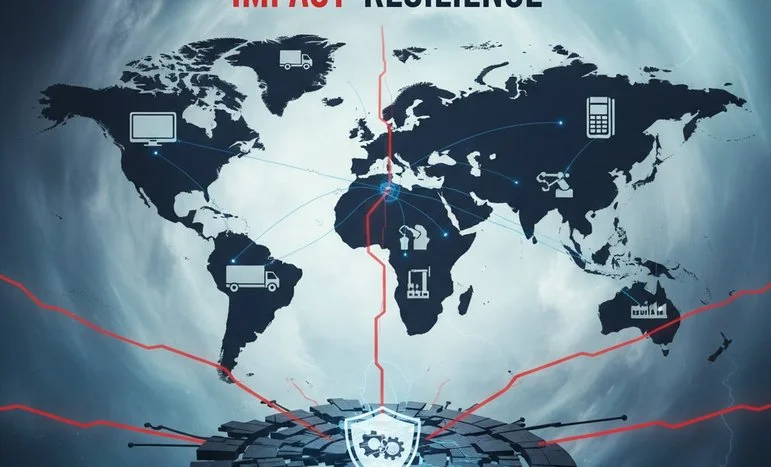
AWS Outage Disrupts Global Operations, Exposes Infrastructure Reliance Risks
Introduction
A sudden AWS outage briefly halted critical online operations across industries worldwide, exposing the deep reliance businesses have on centralized cloud infrastructure. While Amazon Web Services quickly restored functionality, the incident reignited conversations around resilience, redundancy, and digital dependency in a cloud-dominated era.
The event, which affected financial platforms, e-commerce services, and SaaS providers, underscored a growing truth: modern economies depend on a handful of cloud giants for daily continuity.
Global Disruption and Quick Recovery
The outage, lasting several hours, caused interruptions across regions in North America, Europe, and Asia. Businesses reported issues ranging from delayed transactions to API failures, as core hosting services temporarily went offline.
Amazon confirmed that the issue originated in one of its primary U.S. data centers, affecting multiple availability zones. Within hours, AWS engineers rerouted traffic and restored systems, earning praise for rapid recovery despite the widespread disruption.
Still, the ripple effects were significant.
- E-commerce platforms experienced checkout failures and delivery scheduling errors.
- Streaming and communications apps faced connectivity losses.
- Enterprise users saw workflow automation and DevOps pipelines temporarily disabled.
The Broader Lesson: Overreliance on Centralized Clouds
The AWS outage served as a wake-up call for organizations that have built entire operations around single-provider architectures. The incident reignited discussions on multi-cloud strategies and hybrid models that balance convenience with resilience.
Industry experts emphasize that cloud dependency is not just a technical issue but a systemic business risk. From startups to Fortune 500 firms, the question of operational continuity has become a top boardroom priority.
Multi-Cloud and Decentralized Alternatives
Companies are now revisiting redundancy frameworks, exploring ways to distribute workloads across multiple providers such as Microsoft Azure, Google Cloud, and emerging decentralized platforms.
- Multi-cloud adoption allows for automatic failovers between providers.
- Edge computing and on-premise backups add localized resilience.
- Decentralized storage networks (like Filecoin or Arweave) offer redundancy without full reliance on major vendors.
Infrastructure Resilience in the AI Era
The outage also highlighted the intersection of cloud reliability and AI workloads. As enterprises integrate AI-driven analytics, automation, and generative models, uptime becomes even more critical. A few hours of disruption can paralyze machine learning pipelines, delay insights, or interrupt mission-critical services.
AI infrastructure providers now stress the importance of distributed compute systems capable of maintaining operation even when central nodes fail.
Economic and Operational Impact
Preliminary estimates suggest the outage caused millions in lost productivity and transaction delays, particularly in fintech, logistics, and e-commerce.
However, analysts note that AWS’s rapid response minimized long-term financial impact, a testament to the company’s operational depth.
Investors appear largely unfazed, viewing the incident as a short-term glitch in an otherwise robust service network. AWS’s transparency during recovery helped preserve client trust, even as competitors used the moment to tout their own reliability metrics.
Renewed Focus on Contingency Planning
In the aftermath, IT leaders are revisiting disaster recovery protocols and service-level agreements (SLAs) to ensure business continuity.
Best practices gaining traction include:
- Implementing cross-region replication for mission-critical data.
- Scheduling periodic failover simulations to test resilience.
- Integrating AI-based monitoring tools for predictive failure detection.
Cybersecurity experts also highlight that resilience planning must extend beyond technical redundancy to include communication strategies and crisis management frameworks.
The Future of Cloud Reliability
The AWS incident serves as both a warning and a benchmark. The speed of recovery demonstrated the maturity of modern cloud engineering, yet the global impact of a single disruption revealed ongoing structural vulnerability.
Enterprises are now accelerating plans for hybrid architectures, merging cloud agility with localized control. As digital economies expand, resilience will define competitiveness — not just performance or cost.
The brief AWS outage may have lasted only hours, but its message will echo for years: global business continuity cannot depend on single points of failure.
While Amazon’s swift restoration showcased technical excellence, the event underscored the necessity of diversified infrastructure and strategic redundancy across the digital ecosystem.
In the race to build smarter, faster, AI-ready systems, infrastructure resilience is emerging as the true foundation of digital trust and stability.
We appreciate that not everyone can afford to pay for Views right now. That’s why we choose to keep our journalism open for everyone. If this is you, please continue to read for free.
But if you can, can we count on your support at this perilous time? Here are three good reasons to make the choice to fund us today.
1. Our quality, investigative journalism is a scrutinising force.
2. We are independent and have no billionaire owner controlling what we do, so your money directly powers our reporting.
3. It doesn’t cost much, and takes less time than it took to read this message.
Choose to support open, independent journalism on a monthly basis. Thank you.














